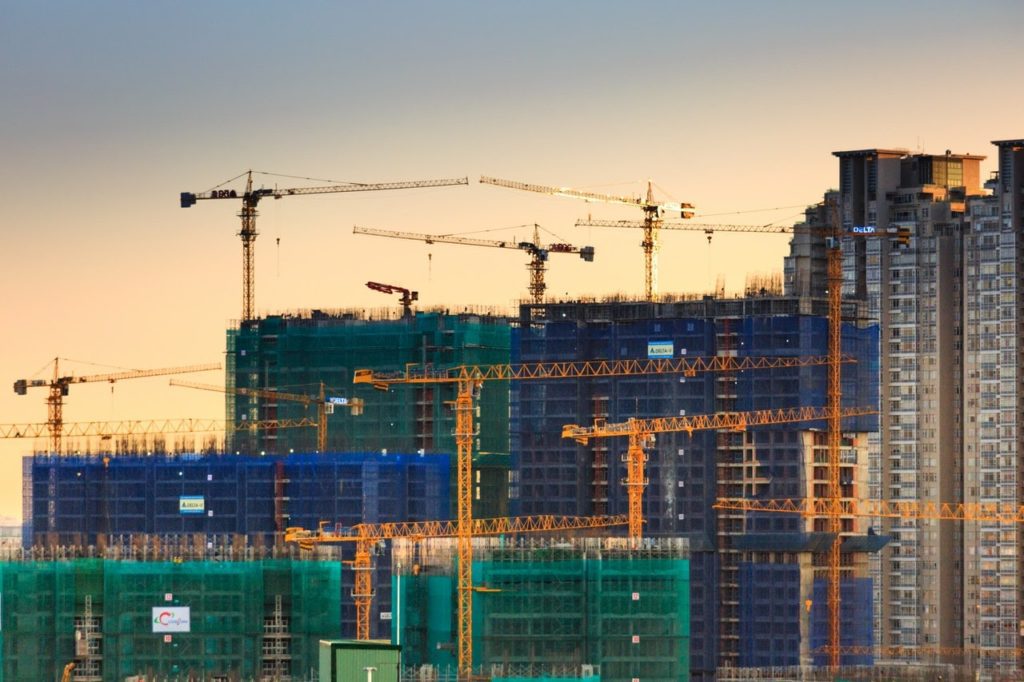There are stark differences between residential and commercial construction, and these differences have a significant influence on how contractors approach different projects. The main differences focus on building codes, materials, costs, equipment, and project timelines.
Residential properties include single-family homes, multiplexes (duplex, triplex, etc.), townhouses, condominiums, and housing cooperatives.
Commercial properties, on the other hand, are constructed for business purposes. Some examples include shopping malls, storage warehouses, office buildings, factories, and hospitals.
You may also find hybrid, or ‘mixed-use,’ properties. These are large multi-family properties, such as apartment buildings, that include some spaces for business activities. In the industry, such large apartment buildings are in the commercial property category. They use many of the same materials and construction techniques and follow the same building codes as properties meant purely for business.
Construction contractors need to understand the differences between residential and commercial construction so that they can focus their project planning correctly. Here are the important residential and commercial distinctions that contractors need to understand to succeed in the industry.
Building Materials
Contractors need to source different materials depending on the design and type of building.
Residential: Due to the relatively small size and budget constraints of a residential construction project, wood frames are standard. Not only are most residential properties small enough to be supported by wood, but timber is also significantly cheaper than the other options. Only the largest residential buildings opt for steel frames, and even then, it depends on the willingness of the owner or investors.
Commercial: Most commercial projects use steel to build their frames. Not only is steel stronger and more resilient, but it is also more flexible than wood, allowing it to bend slightly in the wind and keep a building from toppling. As a result, steel frames are necessary for skyscrapers and other tall commercial or mixed-use structures.
Building Codes
While both residential and commercial construction projects are subject to building codes, the rules for each are very different.
Commercial: Commercial projects need to follow local, state, and federal building codes for their size, design, building materials, construction techniques, plumbing, and electrical systems. Commercial construction contractors need to know all the relevant laws for their projects.
There are also additional standards for commercial construction projects. These include safety regulations related to features such as elevators and fire suppression systems and compliance with accessibility standards. Many commercial projects also have parking lots or parking garages, which come with their own requirements.
Residential: Residential construction projects also have building codes related to quality and safety. However, there are not nearly as many rules, and those that exist are not as complex as the regulation for commercial projects.
Permits and Licenses
Contractors also need to be aware of the permits and licenses required for each type of project. License requirements vary by state and are meant to ensure that contractors are qualified to perform their jobs. In simple terms, construction permits are permissions granted by local authorities. In many places, a contractor needs a license to apply for a building or construction permit.
Commercial: Due to the complexity of commercial construction, there are more permit and license requirements for these types of projects. Commercial developers often need them to work on their chosen construction site, and contractors need a separate permit to perform their specific jobs on the project, as well as separate contracting or trade licenses for all workers. On commercial projects, these accreditations ensure that the people who perform specialized tasks, such as plumbing and electrical contractors, know what they are doing.
Residential: Residential contractors also need to abide by authorization rules before beginning construction or renovation projects. Though residential contractors who perform technical tasks often need a license, those who perform more-general work may not need additional permits, depending on the size and value of the project.
Project Costs
The costs are different for residential and commercial construction projects.
Commercial: Even if there are two buildings of comparable size, the commercial one will cost more. The higher price is caused, in part, by the compliance standards and material requirements. There are also costs related to the equipment, labor, and overhead expenses, such as construction insurance.
Typically, a commercial project needs more skilled labor and specialized equipment. Contractors who work on a commercial project need to be bonded and insured – a cost which they may pass on to the developers and their investors.
Residential: Residential constructions involve less skilled labor and can often be funded out-of-pocket. Also, contractor insurance can be found cheaper for such projects, as the lower value of the project and comparatively lower risk makes it less costly to underwrite.
Project Equipment
The type of equipment used also differs in commercial and residential projects.
Commercial: While labor in most residential projects is manual, large commercial projects need more specialized equipment, such as earthmovers and cranes. This heavy machinery gets rented from contractors via a bidding process, where the project manager picks the cheapest contractor that can handle the work.
The contractors often bring in their own trained personnel to operate the machinery for safety reasons. The complexity of deploying and using such equipment is a major difference between commercial and residential projects.
Residential: All but the largest residential projects can be completed with the use of manual labor and hand-held equipment. While residential projects still require skilled labor, they rarely need the heavy, specialized equipment that is typical of commercial construction.
Design
Commercial and residential structures have design differences that reflect the different locations and functions the buildings occupy.
Residential: Residential buildings have features meant to maximize comfort and rooms that serve specific purposes, such as bedrooms and kitchens. They also have more-significant size restrictions. Everything needs to fit within a relatively compact space.
Commercial: Commercial buildings are generally more extensive and contain more elements, such as stairways and elevators. While commercial buildings do have specialized spaces, they also need to have public areas to accommodate people and facilitate foot traffic. The need for these features affects the overall design.
Project Deadlines
Commercial: Due to the large sums of money involved, commercial projects are subject to tighter deadlines. They need to finish on schedule to avoid running over budget. Also, commercial construction projects run on a strict schedule, with many specialists and equipment operators needing to perform specific tasks at certain times to keep the entire process moving.
Residential: Residential construction projects are not as time-sensitive and do not take as long to complete. However, some residential contractors do not move as quickly to complete the work because of a lack of strict deadlines. For this reason, residential constructions may take longer than similarly-sized commercial projects.

